As an occupational therapist in the school system, I address many fine motor limitations hampering students’ academic performance and independence.
These seven hand motor skills are patterns or sequential movements adapted by the hand to perform a task. They typically rely on the sense of touch, vision, proprioception, and somatosensory function to work effectively.
Hand motor skills include the following patterns:
- Carry: Refers to the act of transporting a hand-held object from one place to another. Shortly after children take their first steps, they begin to exhibit a newfound sense of confidence when it comes to exploring their environment and handling objects. This exciting developmental phase involves a significant improvement in the stability, strength, and control of various parts of their body, including their legs, core, shoulders, arms, and their ability to coordinate hand movements with their eyes. Even the somatosensory system, responsible for perceiving touch and proprioception, plays an essential role in this process. Additionally, the muscles in the shoulders, forearms, and wrists come into play, allowing the child to comfortably hold their hands with palms facing upwards. The muscles in their hands also need to work harmoniously, facilitating contraction. As children progress, they adapt to different sizes and weights of objects, along with varying distances they might carry them. This demands an increased level of stamina and endurance to effectively hold onto and manage these objects while on the move.
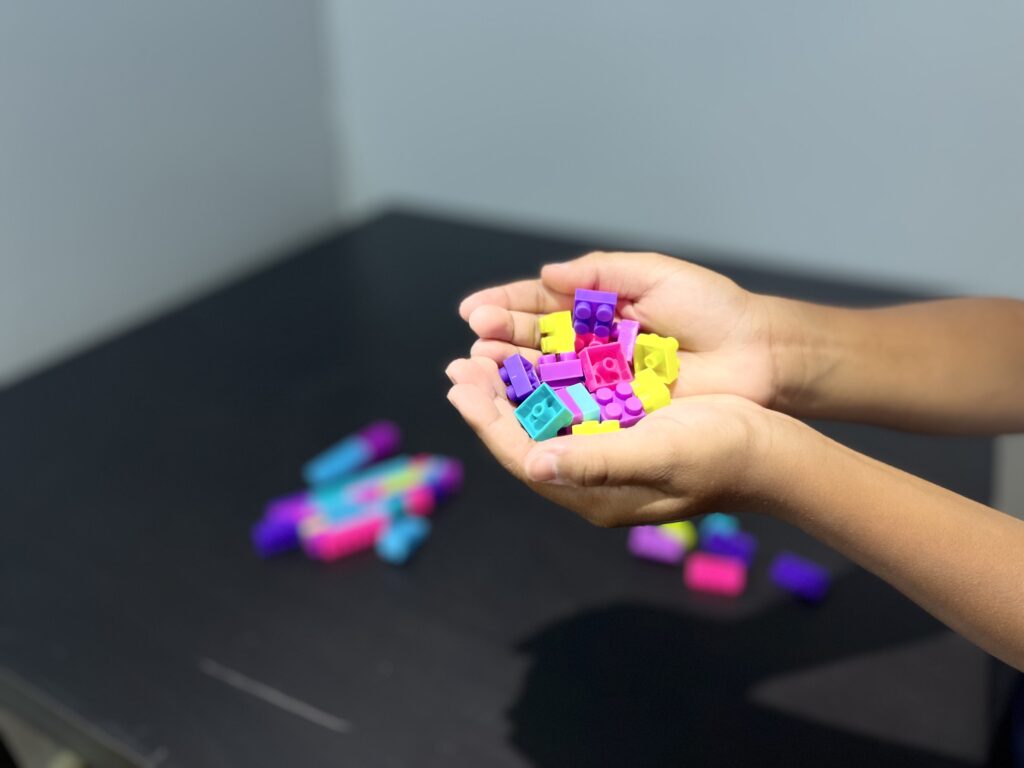
- Bilateral Hand: Refers to the motor skill that requires simultaneous use of both hands to complete a task or activity. As little ones grow and learn, their journey towards mastering bilateral hand coordination is quite fascinating. At the outset, their hand movements might lean towards asymmetry, with their right and left hands often exploring different distances. However, as they progress, a beautiful transformation occurs. Symmetry takes the stage, where both arms collaborate harmoniously, maintaining a similar distance from each other. This shift marks a significant milestone, enabling children to partake in activities that call for the use of both hands together. This remarkable skill begins to take shape around the age of 3 months and gracefully evolves throughout their childhood, continually refining their ability to coordinate their hands in perfect sync
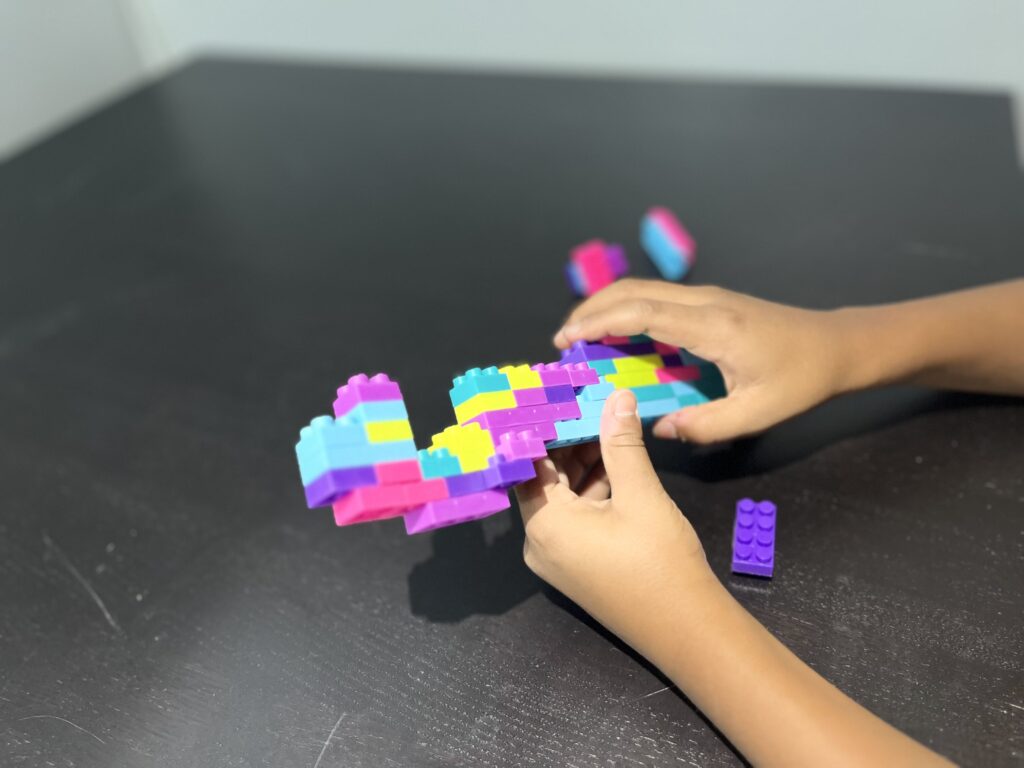
- Hand-Arm: The association of interactive movements and stabilization of arm and hand to perform a task or activity. These movement patterns are engaged when performing carrying activities and activities requiring bilateral use of hands.
- In-Hand Manipulation: Refers to how an object is placed or accommodated in the hand. Navigating the realm of motor skills development in children, in-hand manipulation shines as a captivating and intricate ability to conquer. This skill entails a deliberate orchestration of movement – a symphony of purposeful actions that involve isolating and controlling motion, ensuring stability, and fostering a nuanced command over each finger’s force. At its heart, in-hand manipulation involves five fundamental movement patterns, each with its distinct charm: the graceful finger-to-palm translation, the clever palm-to-finger translation, the artful shift, the subtle simple rotation, and the intricate complex rotation. This captivating skill often takes its initial bow between the ages of 12 to 15 months, as children’s motor prowess blossoms. But the journey doesn’t end there. In-hand manipulation continues to flourish and refine itself throughout the tapestry of childhood and adolescence, painting a portrait of continuous growth and development.
- Grasp: Refers to the motor skill in which the fingers and palm of the hand work together to firmly hold and secure a tool or item. The art of grasping stands as a cornerstone among motor skills, a journey of development that holds the key to a multitude of activities. From daintily picking up morsels of food to crafting stories with toys, from brushing teeth with care to imprinting thoughts onto paper, the essence of grasp threads through our daily rituals. These patterns of grasp are like tailor-made ensembles, carefully designed to match the demands of each task. They gracefully balance precision and power, aligning with the unique contours of activities and the forms of objects at hand. This magical skill unfurls its wings between 4 to 6 months of age, a beacon of growth in a child’s journey. As the years unfold, by age 5, children who are following a typical developmental path have already woven an intricate tapestry of various grasping patterns. Yet, the tale doesn’t halt there. Like a fine wine maturing with time, grasp continues to evolve as children sprout into new stages of growth. As they embrace the world of tools, this skill finds fresh avenues for development, sketching a path of constant refinement.
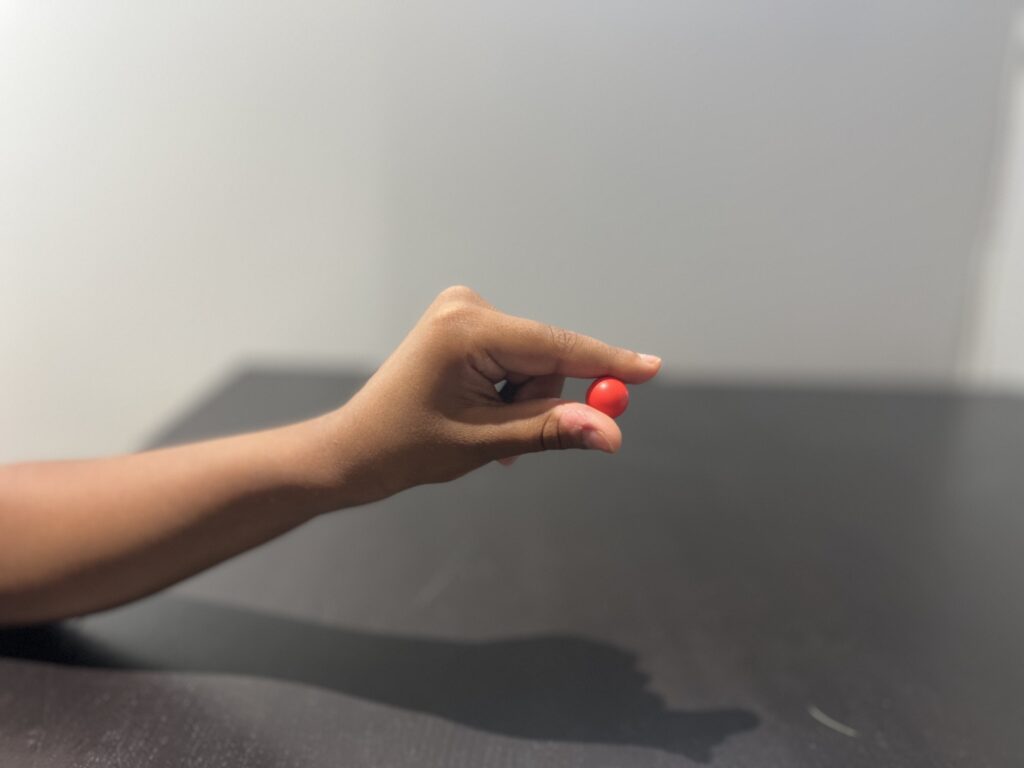
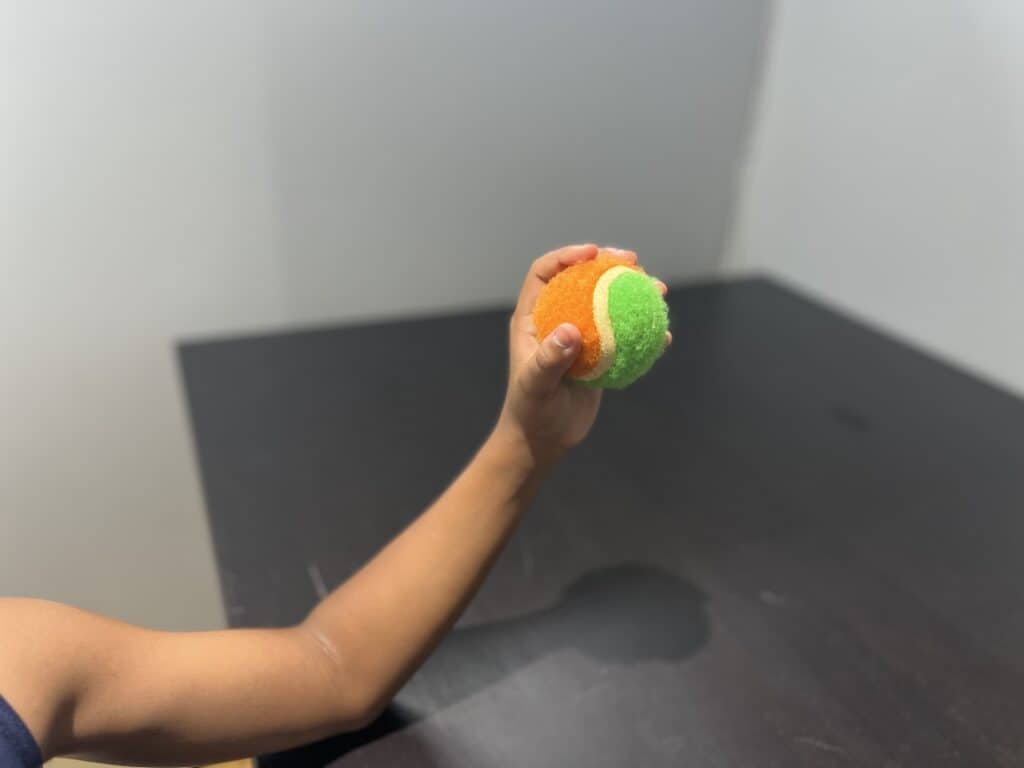
- Reach is a compound motor skill involving the voluntary movement of extending the arm, hand, and fingers to access or interact with objects in the environment. This skill is a cornerstone of children’s development, playing an integral role in mastering the routines of daily living, from essential activities to those that add a touch of creativity and joy. Think of reaching out for nourishment, extending for a cherished toy, adorning oneself with clothes, and beyond. The journey of reaching sprouts in the earliest stages of a child’s life, as their curious eyes lock onto objects that beckon from within their visual range. With each passing day, growth unfurls like petals on a flower, and so does this motor skill. Visual and auditory cues intertwine with their development, gently guiding them on this path. As children embrace their developmental journey, by the age of 12, a milestone is reached: the reliance on visual input for this skill begins to wane, and a newfound sense of mastery blossoms.
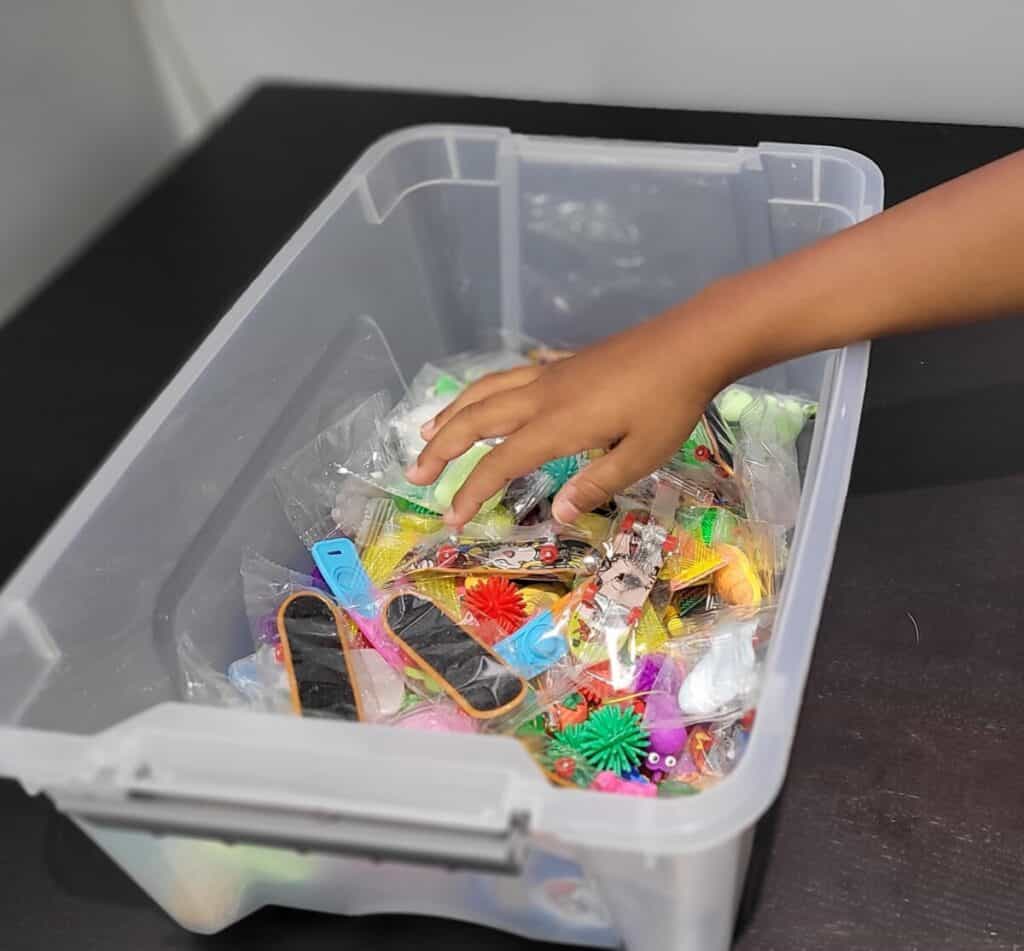
- Voluntary Release: It refers to the motor skill required for intentional release from the hand of an object. Much like the art of grasping, voluntary release stands as a pivotal motor skill in a child’s developmental repertoire. This skill empowers them to engage with the world around them, fostering independent exploration and safer interactions with objects. The enchanting ability of voluntary release first makes its appearance around the tender age of 9 months, a delightful milestone that proceeds to unfold and mature throughout the journey of childhood.
- To learn more about fine motor development, check out our post about fine motor developmental milestones.
How to Boost Hand Motor Skills Development
PLAY, PLAY, and more PLAY. Play is children’s main occupation. It is how children improve their hand-motor skills. Play serves as the magical avenue through which children embark on their journey of environmental discovery, nurturing their cognitive, physical, social, and emotional growth. The gift of ample playtime bestows upon them the tools to master hand-motor skills with remarkable swiftness and finesse. In our contemporary landscape, where schedules often appear tightly woven, and electronic devices sometimes seize the spotlight for the sake of convenience, the importance of prioritizing unstructured play resonates more profoundly than ever.
Carry
Choose activities promoting graded movements or movements with varying degrees at the shoulder, elbows, and forearms to boost this motor skill. For instance, some activities may require for items or toys to be carry closer to the body than others. Some activities may require for children to keep shoulder, elbows and forearms extended. The more diverse the movement patterns the swifter children will master this skill. As a rule of thumb, always begin with larger sizes and lighter weights when it comes to toy’s selection and items we allow children to play with. As the skill develops and children become more at ease and in control of their playful activities, decrease the item’s size while increasing the weight and shape complexity to increase the activity’s fine motor demands.
Bilateral Hand Use
Choose toys or objects that require using both hands simultaneously to boost bilateral hand use. To start, select toys or objects large in size that can be either pull or pushed in a linear direction, ideally over a surface area, be it a tabletop or on the floor—progress by incorporating large toys or objects into playful activities that include lifting and carrying.
As children continue to make progress in this motor skill, select toys that constantly challenge their level of function by decreasing their size. As we decrease the size of the toys, children are challenged in their ability to use both hands to handle and effectively operate the toy. This in terms, launches children in a quest to regain that sense of control and comfort they once enjoyed with the larger toy, springing a new level of mastery of this skill. Over time, as children continue to progress in their development of fine motor skills, they grow more accustomed to the never ending cycle of challenge and regained control that ultimately leads them to higher levels of mastery and independence. And so on, we continue challenging children by introducing toys requiring stabilizing with both hands to stabilizing with one hand while the other hand manipulates the object, think of it like a fishing rod. lastly, provide toys that they need to manipulate with both hands while stabilizing at the same time like a Rubik’s Cube for instance.
In-Hand Manipulation
To boost in-hand manipulation skills, we first need to determine children’s tactile defensiveness. What do I mean by tactile defensiveness? It is a sensitivity or aversion some children demonstrate to textures that feel uncomfortable to the touch. So be mindful of their facial expressions and body language when you are giving them a new toy to play with. Children are very honest so if they feel that something is making them feel uncomfortable, they will either verbally express it or demonstrate it with their body language.
We can start by sparking development in in-hand manipulation by introducing toys they can fit by using both hands at the same time, progressing to items that fit in one hand, but are bulking in size like a cube or a block with well defined but simple shapes. As children become more familiar with these sort of toys and their ability to maneuver them improves, we begin to decrease the size of the toys and increase the complexity of their shapes an example of this could be large pegs or beads of different shapes.
Finally, we introduce children to toys that are flat and small like coins and small pegs. One game I love to play with my students, I call it “The Mystery Toy”. This is a game in which children need to tap into their stereognosis power, their ability to identify familiar items by touch only without visual aid. The familiar item is placed in the child’s hand and the child is supposed to identify it correctly by moving it around in the hand without looking and without using the other hand. This type of game promotes finger isolation, dissociation of movements, and incorporates the thumb. As this motor skill progresses, children can be introduced to smaller toys with slimmer surfaces and more movable, like small and round toys.
Grasp
To boost grasping skills, like boosting in-hand manipulation skills, we first need to determine tactile defensiveness or sensory discrimination to choose toys or items provided to children. We also want to take their interest into consideration when making this selection.
Begin with activities incorporating large toys, cube or squared shape toys, and malleable items like Play-Doh or Thera putty. Provide toys that children can twist, pull and push with the hand getting them use to engaging their power grasp. Also provide items to As this motor skill progresses, we can initiate activities incorporating small-size items with flat or slim surface areas and round items.
Reach
To boost this motor skill, the type of toy being incorporated into the activity is not as important as the placement of the item in relation to the child. Provide children with the “just right” level of challenge, meaning challenging enough that the child will be able to successfully try it. Based on the child’s level of function, determine how far from the body and how far from the midline the toy or object will be placed.
Begin by placing items in the horizontal plane, either tabletop or floor, close to the body and off to the side. It is developmentally easier for children to reach for toys placed to either the right or left than items placed in front of them (midline). As children begin to exude more confidence in their reaching abilities, we can then begin to place items further from their bodies and closer to midline or right in front of them.
Eventually, introducing children to playful activities that require reaching with both hands instead of with only one. And by introducing games where toys are no longer placed in the horizontal plane but in the vertical plane either above shoulder level or below it.
Voluntary Release
One of the ways to boost this motor skill is by having children play activities that require placing items in a container. Although the size and shape of the object are important, the placement of the container in reference to the child’s midline and shoulder level is just as important. Start by having children drop mid-size objects into containers placed on the floor beside where the child is sitting.
Once the child has mastered this, place the container on the table to the side of the midline at arm’s length. As the child continues to make progress, bring the container closer to the body and into midline, decreasing the size and increasing the complexity of the shape of the object. Finally, decrease the size of the container and challenge the child to be less reliant on visual input while releasing objects into the container.
It is important to keep in mind that children are unique and different in the way and rate they develop. So, before implementing any of these recommendations, it is important to understand the child’s level of function. I hope this post was helpful and informative to you. Below, I have added a list of toys and links I recommend for hand-motor skill development. You may also like to check out our post on fine motor skills and activities to promote hand strength.
- MindWare CupStruction
- Battat – Toddler Peg Board
- Colorful Sorter Cube Box & Shapes
- Shapes Chunky Puzzle
- Floor Puzzle
- Theraputty
- Jumbo Crayons
- Tong and tweezers
- Tool Set
Company Motto: “Empowering our children goes a long way in helping them become independent and build their self-esteem.”
